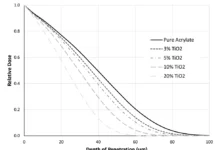By Stephen C. Lapin, Ph.D., broadbeam applications specialist, PCT Engineered Systems, division of Ebeam Technologies, Comet Group
Q. How Does Electron Beam Treatment Affect Polymer Substrates?
A. A well-known use of electron beam (EB) technology is the treatment of polymer materials. The most commonly treated polymer is polyethylene, including homopolymers in various grades as well as polyethylene-based copolymers. The main reason for EB treatment of polyethylene is to induce crosslinking, which can provide desired improvements in thermal and mechanical properties of the material. A well-established polyethylene crosslinking application is the production of shrink films used in food packaging.
Any type of polymer can be subjected to EB treatment. Chain scission and/or crosslinking will occur in most polymers. Some polymers, on the other hand, are very resistant to the effects of EB exposure. The process that predominates depends on chemical structure and morphology of the polymer. Several references are available that review the ways different polymers are affected by ionizing radiation.
The EB curing of inks, coatings and adhesives is well established for packaging applications. The process usually involves EB-induced polymerization of formulations based on acrylate functional monomers and oligomers. The process is attractive for flexible packaging since it allows high line speeds and produces cured materials with very low odor and migration.

In most cases, the substrates used to produce flexible packaging are polymer films. The goal is to EB-cure the inks, coatings and adhesive layers on the surface of these films; however, some of the EB energy will dissipate into the films themselves; therefore, it is important to understand how the EB might affect these films.

Table 1 provides a list of some common packaging films, along with a summary of how EB affects each of these materials. Probably the only material that generally should be avoided is polyvinyl chloride (PVC). Even though polypropylene undergoes chain scission, the film’s functional properties remain suitable for most packaging applications. Figure 1 shows the break strength of commercial polypropylene packaging films as a function of electron beam dose. Clear and white (cavitated) films were used. The clear film is inherently stronger than the white film. The results show a relatively small decrease in strength after a typical cure dose of 30 kGy.

The process of EB curing inks, coatings and adhesives can have beneficial effects on mechanical- and heat-resistance properties of underlying polyethylene substrates. Sometimes, however, crosslinking may not be desirable. This can be the case for heat-sealable packaging in which EB crosslinking increases the melt temperature, adversely affecting the sealing properties. An example is a mono-web, heat-sealable, EB-printed and/or coated package (Figure 2). The effect of the EB can be mitigated by reducing the voltage, which reduces the EB penetration into the substrate. In this example, reducing the EB voltage to 90 kV provides good dose uniformity through the coating layer while delivering a near zero dose on the heat-sealable side of the package.
In addition to considering the effect of EB on the film’s thermal and mechanical properties, one may need to consider its effect on the migration properties, which could impact the film’s suitability for use in food packaging. These concerns may be minimal if the package construction includes a functional barrier between the EB-treated film and the food. Food packaging compliance usually can be confirmed by migration testing of the proposed package construction. Migration testing might consider residual components from the EB inks, coatings and adhesives, as well as degradation products from the film substrate, including additives such as antioxidants and slip agents.
In summary, EB exposure can affect polymer substrates used in EB curing applications. It is important to be aware of these effects; however, in most cases, polymer films can be, and are, used very successfully in electron beam curing applications.
Stephen C. Lapin, Ph.D., is a BroadBeam Applications Specialist at PCT Engineered Systems, a division of Ebeam Technologies, Comet Group. He can be reached at sclapin@teampct.com.






